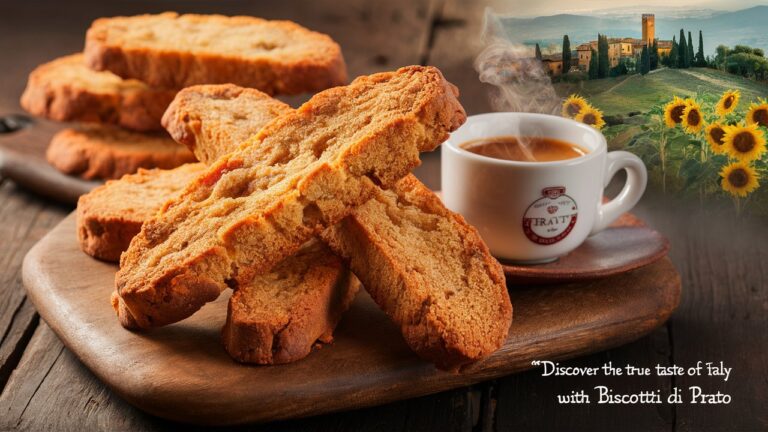Introduction
When it comes to traditional Italian sweets, few delicacies are as iconic and beloved as Biscotti di Prato, also known as cantucci. These golden, twice-baked almond biscuits carry centuries of history and continue to represent the culinary heart of Tuscany. Unlike softer cookies or pastries, Biscotti di Prato are known for their distinct crunch, aromatic almond flavor, and ability to be enjoyed both as a snack and as part of Italian dining rituals. From their humble origins in the Tuscan town of Prato to their widespread global recognition, these biscuits have stood the test of time, embodying both simplicity and sophistication.
The History of Biscotti di Prato
Biscotti di Prato originated in the Tuscan city of Prato during the Renaissance period. Their name comes from the Latin word “bis coctus,” meaning “twice cooked,” a method that gave them their signature crisp texture and long shelf life. Originally prepared as a practical food for travelers and soldiers due to their durability, these biscuits eventually became a staple in Tuscan households. Over time, their role shifted from being a necessity to becoming a symbol of Italian tradition and hospitality. Today, when someone mentions Biscotti di Prato, it immediately evokes images of warm Italian evenings, families gathered around tables, and the perfect pairing with a glass of Vin Santo wine.
What Makes Biscotti di Prato Unique?
While Italy is known for its variety of pastries and sweets, Biscotti di Prato hold a special place because of their unique preparation and distinct texture. The biscuits are baked twice—first as a loaf and then sliced and baked again to achieve their iconic crunch. Unlike softer cookies, they are meant to be dipped, most traditionally in Vin Santo, a sweet Tuscan dessert wine that softens the biscuit while enhancing its flavor. The use of whole almonds, often toasted, ensures a rich nutty taste in every bite. The combination of crispness, almond aroma, and subtle sweetness makes Biscotti di Prato stand out from other Italian confections.
The Classic Recipe for Biscotti di Prato
Traditional Biscotti di Prato are made with simple yet high-quality ingredients: flour, sugar, eggs, and almonds. No butter or oil is added, which contributes to their dry and crunchy texture. The dough is shaped into logs, baked until firm, then sliced into oblong biscuits and baked again to achieve perfect crispness. This process not only enhances the flavor but also ensures they can be stored for weeks without losing quality. Modern variations sometimes include ingredients such as hazelnuts, pistachios, dried fruits, or even a touch of chocolate, but the authentic version remains almond-based and deeply rooted in Tuscan tradition.
Cultural Significance and Pairings
In Italian culture, Biscotti di Prato are more than just a dessert; they are a ritual. Traditionally served at the end of a meal, they are enjoyed by dipping into Vin Santo, creating a balance between the crunchy biscuit and the silky sweetness of the wine. Outside of Tuscany, they are often paired with coffee, cappuccino, or hot chocolate, making them versatile across cultures. The act of sharing biscotti at the table has become a symbol of hospitality and togetherness, making them not just food but an expression of Italian tradition and lifestyle.
Biscotti di Prato vs. Other Italian Biscuits
While Italy is home to a wide variety of biscuits such as amaretti and savoiardi, Biscotti di Prato stand out for their durability, crunch, and almond-rich profile. Amaretti are softer and made with almond paste, while savoiardi (ladyfingers) are light and airy, often used in desserts like tiramisu. Biscotti di Prato, however, are enjoyed on their own or with beverages, making them both a standalone treat and a cultural icon. Their double-baking method gives them a distinct identity that is difficult to replicate in other biscuits.
Conclusion
Biscotti di Prato are not just biscuits—they are a piece of Tuscan history, an embodiment of Italian tradition, and a timeless delight that has charmed food lovers across centuries. With their crunchy texture, almond-rich flavor, and cultural significance, they remain one of Italy’s most cherished sweets. Whether enjoyed in the traditional way with Vin Santo or paired with modern favorites like coffee or tea, Biscotti di Prato continue to connect people to the flavors and traditions of Tuscany. Their story is a reminder that the simplest recipes often create the most lasting impressions.
FAQ (Frequently Asked Questions)
1. What are Biscotti di Prato?
Biscotti di Prato are traditional twice-baked Italian almond biscuits from Tuscany, known for their crunchy texture and long shelf life.
2. Why are they baked twice?
They are baked first as a loaf, then sliced and baked again to achieve the dry, crisp texture that makes them perfect for dipping.
3. How are Biscotti di Prato traditionally eaten?
They are usually dipped in Vin Santo, a Tuscan dessert wine, but they can also be enjoyed with coffee, cappuccino, or tea.
4. What makes them different from other biscotti?
While the term “biscotti” refers to many types of cookies in Italy, Biscotti di Prato specifically refers to almond biscuits from Prato that are twice baked for crunchiness.
5. Can Biscotti di Prato be stored for a long time?
Yes, their dry texture allows them to stay fresh for weeks when stored in an airtight container.
